Recent research progress for upconversion assisted dye-sensitized solar cells
2021-08-26XugengGuoWenpengWuYuanyuanLiJinglaiZhangLiWangHansgren
Xugeng Guo,Wenpeng Wu,Yuanyuan Li,Jinglai Zhang,Li Wang,*,HansÅgren,c,*
a Institute of Upconversion Nanoscale Materials,College of Chemistry and Chemical Engineering,Henan University,Kaifeng 475004,China
b Henan Center for Outstanding Overseas Scientists,Henan University,Kaifeng 475004,China
c Department of Physics and Astronomy,Uppsala University,Box 516,SE-751 20 Uppsala,Sweden
ABSTRACT Upconversion(UC)technology makes it possible to harvest infrared(IR)light from the sun and has increasingly been employed in recent years to improve the efficiency of solar cells.The progress in the area concerns both research on fundamental principles and processes of UC and technologies of device fabrication.Significant increase of important solar cell parameters,like short-circuit photocurrent density and open-circuit photovoltage as well as the total photon-to-current efficiency,has been accomplished.We here review the research published during the last few years in the area,in particular we consider the two most cherished techniques,namely the incorporation of upconverting nanophosphors directly into the photoanodes of the solar cells and the introduction of plasmonic metal nanoparticles co-existing with the UC particles.Other ways to achieve strong field enhancement,and the use of the non-linear nature of UC,is to apply microlenses,with or without assisting plasmonic excitation.Further enhanced UC action has been demonstrated by broad band and effective harvesting by organic IR antennas,with subsequent mediation by an intermediate nanoshell of the energy into the upconverting core.Codoping,nanohybrid and layer-by-layer technologies involving upconverting particles as well as the use of upconverting nanoparticles in hole-transport and electrolyte layers,tested in recent works,are also reviewed.While most of these technologies employ upconverting rare earth metals for sequential photon absorption,the main alternative technique,namely triplet-triplet annihilation UC using organic materials,is also reviewed.It is our belief that all these approaches will be further much researched in the near future,with potentially great impact on solar cell technology.
Keywords:Upconversion nanoparticles Dye-sensitized solar cells Infrared light Triplet-triplet annihilation Photovoltaic systems
1.Introduction
The quest for renewable energy is of fundamental concern for modern society,with clean,efficient renewable energy technologies ready to compete head to head with oil,gas,coal and even nuclear energy.No longer can society sustain the levels of air pollution,habitat destruction and climate change that have been the price of burning fossil fuels.Renewable energy will play a dominant role as we look for ways to diversify our economy,restore our environment and secure our place in the new global economy[1].In order to minimize anthropogenic alterations of the world climate there is an urgent need to develop technologies capable of generating tens of terawatts of carbon-free,renewable and cost-competitive power over the next 40 years[2-4].Among the contenders competing to replace fossil fuels,photovoltaic(PV)systems provide the only renewable energy source sufficiently abundant to meet these demands[5-7].In fact,more solar energy strikes the surface of the Earth in a single hour,than is what is provided by all of the fossil-fuel energy consumed globally in one year[8].
PVs offer many advantages including low maintenance requirements and environment friendly and already have a large number of applications[9,10].However,the energy generated by PV systems is significantly more expensive for the end user,as compared to‘grid’-energy generated by traditional fossil-fuel based generators[11].The major problems in attaining‘grid parity’with PV systems to date have been high manufacturing costs and/or low efficiency.The first-generation wafer-based(multi-and mono-crystalline)Si solar cells are stable and show efficiencies at 15%-25%[12,13].Nevertheless,due to the complex materials processing,these solar cells are inherently expensive to produce[14-16].An industrially viable alternative is based on thin film materials.Such second-generation devices are somewhat cheaper,but are less efficient in the energy conversion process[17-20].Other alternatives,e.g.,dye-sensitized solar cells(DSSCs),have been proposed to be more cost efficient[21-24].From the efficiency point of view dye sensitized solar modules are in competition with a-Si modules yet have still to prove their reliability and long-term stability under real conditions[25-30].At any rate,these different alternatives introduce incremental improvement in PV systems performance and economy,which significantly hinders their widely spread usages.Organic semiconductor solar cells bear the potential to provide cheap electricity,since they can be fabricated by high throughput printing processes on flexible substrates[31-33].More recently perovskite materials have attracted a worldwide focus,however,presently neither efficiency nor long-term stability are acceptable for practical applications[34-38].
By hybrid approaches using organic polymers for facile material processing and nanoparticles for efficient charge generation and long lifetime,major hurdles encountered today in solar cells could be overcome[39-42].Significant improvements in the cost and efficiency of solar-to-electric energy conversion systems require a careful design/selection of novel material architectures as well as a fundamental understanding of the synthesis,structure and properties of the materials used in their assembly.In particular,emerging and novel technologies that potentially allow for costefficient device production from the present piece-wise device handling to roll-to-roll device fabrication technologies would imply a step-change to the industry.The combined effect of low cost and high efficiency could imply a paradigm-shift in the PV industry and in the society.
Like other types of solar cells,DSSCs suffer from a number of loss mechanisms(Fig.1)[43]which have triggered research for improved efficiency[44-49].The commonly applied dyes have band gaps which absorb only in the visible region,leaving out important parts of the ultraviolet(UV)and infrared(IR)regions of the solar spectrum[45,50].In particular,this absorption feature precludes DSSCs from utilizing the IR photons that constitute almost half of the solar energy[51,52].Efforts to remedy the situation by designing IR responsive photosensitizers have been hampered by poor electron injection efficiency and high charge recombination rates[46,53-55].As alternative,upconversion(UC)technology has been advocated and widely tested as a viable path towards beating the transition losses[56-60].Fig.2 presents the scheme of the harvesting of infrared sunlight by upconversion to visible light.The schematic mechanisms of up-and downconversion are shown in Fig.3.The UC can be largely divided into two domains:triplet-triplet annihilation(TTA)in organic media producing efficient singlet emission in the visible range[61-64],and upconverting through stepwise absorption of IR photons[65-70].
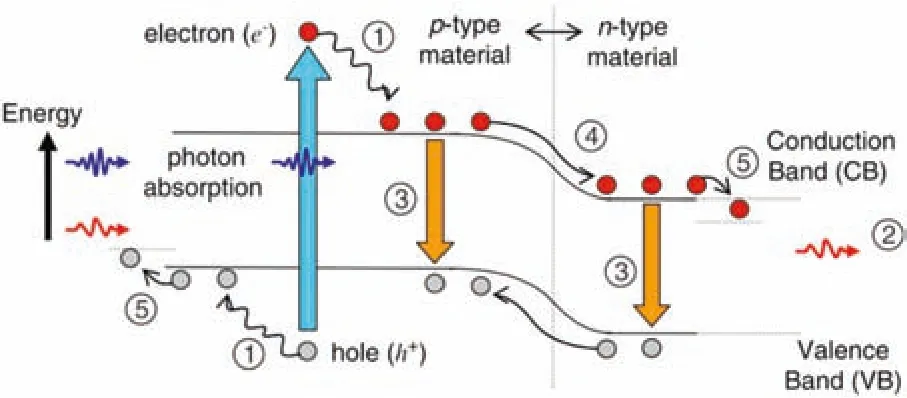
Fig.1.Loss processes in a single-junction solar cell:(1)lattice thermalization loss;(2)transparency loss;(3)recombination loss,(4)junction loss;(5)contact voltage loss.Reproduced with permission[43].Copyright 2006,Elsevier.
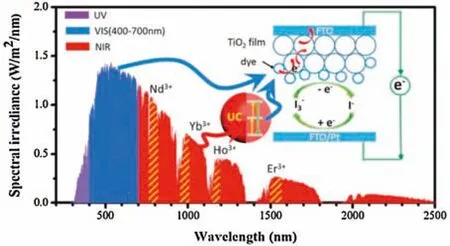
Fig.2.Scheme illustrating the harvesting of infrared sunlight(700-2500 nm)by upconversion to visible light(400-700 nm)to which a typical DSSC structure can respond to(inset).Reproduced with permission[59].Copyright 2018,the Royal Society of Chemistry.

Fig.3.Mechanisms of(a)down-conversion,(b)cross relaxation(CR),(c)excited state absorption(ESA)and(d)energy transfer up-conversion(ETU).Reprinted with permission[60].Copyright 2013,American Chemical Society.
Light UC in this definition generally refers to a process in which two or more photons are sequentially or step-wise absorbed via real intermediate long-lived electronic states to produce one short wavelength photon at the near-infrared(NIR),visible or UV ranges.Upconversion nanoparticles(UCNPs)mostly consist of lanthanidedoped dielectric nanomaterials whereby lanthanide ions are diluted in an appropriate inorganic host lattice with a dimension of less than 100 nm.Rare-earth UC materials are thus dilute guesthost systems in which trivalent lanthanide ions are embedded in an appropriate host lattice[71].The involvement of real intermediate energy levels enables light UC to be efficiently produced with an excitation power density as low as~0.1 W/cm2,easily provided by low cost continuous-wave laser diodes or noncoherent light sources such as bulb lamps and light emitting diodes.This is in remarkable contrast to the high power density excitation(>106W/cm2)required in nonlinear multiphoton absorption or second harmonic generation.Moreover,lanthanide ions display line-like sharp emission and exhibit high resistance to photobleaching and photochemical degradation.The wave functions involved in their 4f-4f electronic transitions are well localized within a single ion.As a consequence,UCNPs do not exhibit quantum confinement effects that are clearly manifested in semiconducting materials,and show luminescence that is quite stable in varying environments.
By a judicious selection of one or more lanthanide dopants,it becomes possible to generate upconversion luminescence(UCL)at a number of selective wavelengths,to allow for multiplexed absorption and emission[72].The required low excitation power density,the ability of efficient frequency up-conversion at IR,the easily defined UC wavelength,as well as the nanometer size dimension promise the use of light UC materials in solar cells.Thus the frequency up-conversion of IR can be useful for harvesting IR photons for their conversion to higher energy photons which can then readily be absorbed by current solar materials.For example,Yuan et al.produced UCNPs embedded solar cells and obtained a significant enhancement of the solar cells efficiency[65,73].Although encouraging results have been obtained,there remain hurdles to their practical use,including:(i)Weak and narrow IR absorption due to the nature of f-f transitions;(ii)Limited assortment of wavelengths for UC and its utilization for solar energy conversion of IR photons;(iii)Relatively low UC efficiency.Thus the quantum yield of UCNPs is low under solar irradiance,the absorption cross-section of UCNPs is small,the absorption spectra range of each doped Ln is narrow,as a result,the contribution from UCNPs under solar irradiation could be too low to make a significant difference to solar cells efficiency.Therefore,many strategies have been applied to overcome these obstacles.As an example Chen et al.applied dye-coated UCNPs to dramatically enhance the absorption of UCNPs,then to further sensitize DSSCs[74].Fig.4 presents the proposed dye-sensitized upconversion core/shell structure as well as its energy transfer pathways[75].
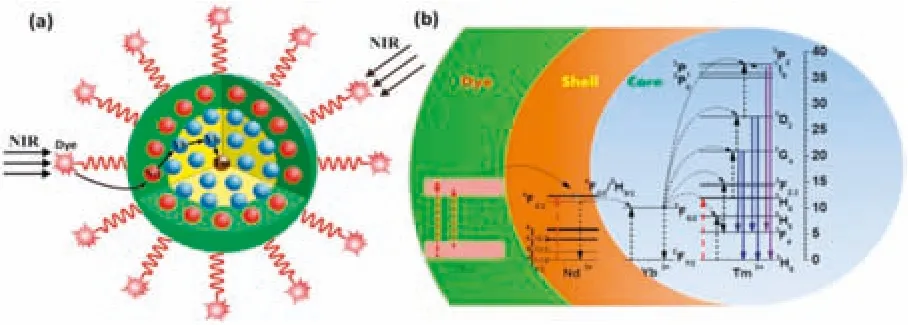
Fig.4.Schematic illustration of dye-sensitized upconversion in a core/shell structure.(a)The configuration of the proposed structure.(b)The energy transfer pathways in dye-sensitized core/shell structure.Reprinted with permission[75].Copyright 2013,American Chemical Society.
Compared with a control sample without dye-coated UCNPs,there was an overall solar cells efficiency enhancement of 13.1%.Another well explored way to enhance the NIR absorption of UCNPs sensitized PV devices is through the plasmonic effect[76].Due to the surface plasmon resonance(SPR),the local electricmagnetic field around the metallic particles is dramatically enhanced.When UCNPs are put in this strong electromagnetic field,the absorption cross-section of the UCNPs are enhanced.An 8.4%(relative)efficiency enhancement of perovskite solar cells(PSCs)with UCNP-incorporated plasmonic substrate is reported by Park et al.[77].Except increasing the absorption,another strategy is to broaden the absorption range.Instead of doping solely one type of sensitizer,multi sensitizer doping,(e.g.,using both Yb3+and Nd3+),can be applied to broaden the absorption range.
These examples are just a few of a broad range of undertakings and research of different processes and materials,that now are ongoing for promoting UC assisted solar cells.Although the field was reviewed as late as in 2018[59],its swift expansion during the last three years calls for a complementary reviewing,which thus is the purpose of the present work.
2.Upconversion assisted dye-sensitized solar cells
2.1.Solar cells with upconverting nanophosphor incorporated photoanodes
Inclusion of UCNPs into the solar cell as the photoanodes is one of the most common pathways to achieve higher power conversion efficiency(PCE)as it serves as an efficient way to extend the harvesting spectral range of solar cells to the IR region.It has recently been widely utilized in various solar cells including DSSCs,PSCs,quantum dot-sensitized solar cells(QDSSCs)and other types.
In 2018,Sun et al.synthesized tri-doped NaYF4:Mn2+,Yb3+,Er3+nanoparticles and merged it into TiO2photoanodes(Fig.5),which were applied for QDSSCs as an alternative to pure DSSCs[78].The UCNPs could not only afford the frequency UC to exclude the NIR transmission loss,but also utilize more electrons produced by the photons emitted in shorter wavelength range that can be reabsorbed by QDs.Short-circuit photocurrent density(JSC)could be obtained as high as 21.30 mA/cm2with open-circuit photovoltage(VOC)of 0.54 V,which can be compared with the JSCof 14.67 mA/cm2and VOCof 0.48 V for those of pure TiO2photoanodes under one sun illumination.The photocurrent density-photovoltage(J-V)measurement indicated a 42.6%increasement for the PCE with the optimized composition of 8 wt% UCNPs/TiO2.
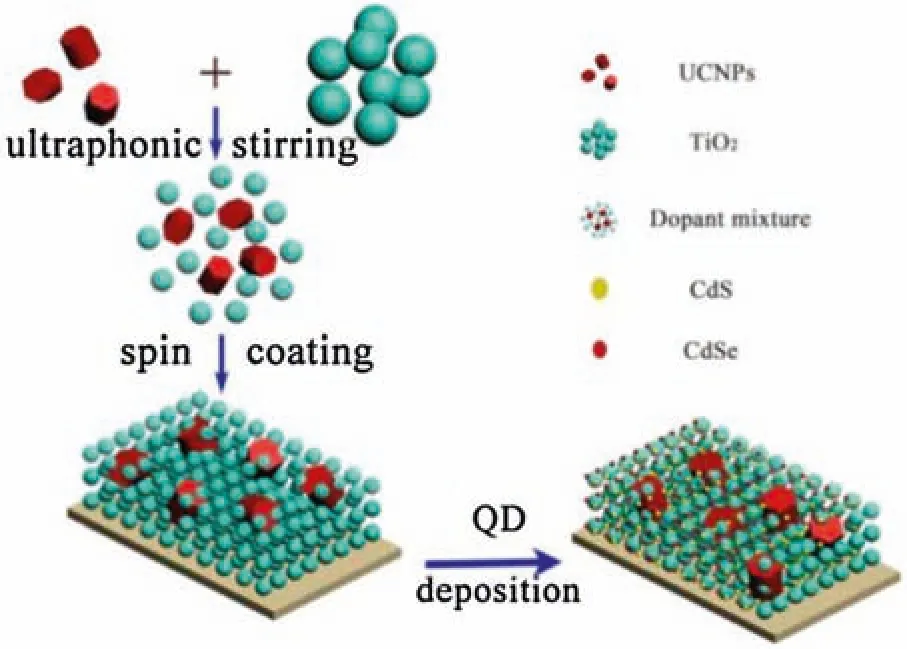
Fig.5.Sketch diagram of anode structure and step by step fabrication processes of TiO2 photoanode.Reproduced with permission[78].Copyright 2018,Taylor &Francis Group.
Later on,the Yb3+/Er3+co-doped TiO2photoanodes were also utilized to fabricate QDSSC by Qu et al.[79].A 3.53% conversion efficiency could be achieved by optimizing a composite film and by the harvesting of NIR light because of the UC process.In addition to harvesting the NIR light,the amplified cell performance also benefited from the influence of light scattering of the upconverterdoped TiO2spheres.
The distinct advantages of UCNPs,such as prominent electron conductivity and UCL,have also been widely utilized recently to improve the PCEs of the DSSCs including TiO2nanowire arrays(TNWAs)/Yb-Er-F(YEF),tri-doped TiO2and UCNPs(YEF-TiO2-UCNPs).With hydrothermal and spin-coating methods,photoanodes using Ti mesh-supported“TNWAs/YEF-TiO2-UCNPsxP251-x”as basis were constructed by Zhang et al.[80]to further improve the PCEs of the DSSCs.Fig.6 presents a flow chart to prepare a fully flexible DSSC of a Ti mesh-supported TNWAs/YEF-TiO2-UCNPsxP251-xcomposite structure.With solar irradiation of 100 mW/cm2(AM 1.5 G),the JSCand PCE could be obtained as 12.81 mA/cm2and 5.54%,respectively,on the basis of a“TNWAs/YEF-TiO2-UCNPs60%P2540%”composite structure,which showed enhancements of 45.7% and 37.8% relative to TNWAs/P25100%(8.79 mA/cm2,4.02%),respectively.The enhancement is attributed to the“one-dimensional nanoarrays/nanoparticle”composite structures,with excellent photogenerated electron transport capacity and large specific surface area.Moreover,the onedimensional TiO2nanostructures on the Ti mesh with good bendability could be utilized to prepare for portable and flexible DSSCs.
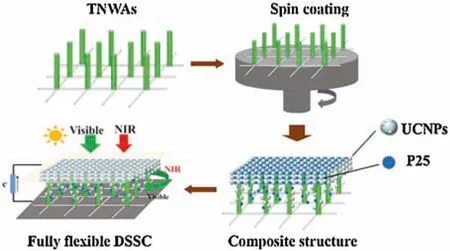
Fig.6.A flow chart of preparation of Ti mesh-supported TNWAs/YEF-TiO2-UCNPsxP251-x composite structured fully flexible DSSC.Reproduced with permission[80].Copyright 2019,Elsevier.
During the same period of time,other similar upconversion phosphors(UCPs)-TiO2composite photoanodes were designed by Mao et al.(Fig.7)[81].To harvest more light in DSSCs the UC β-NaYF4:Yb3+,Er3+phosphors were mixed with titania P25 powders.Also in these constructions the incorporation of UCNPs into the photoanodes offers benefit from light scattering that contributes not only to the traveling distance of light within the photoelectrode films,but also to the UC of NIR light into visible light.However,the addition of such UCNPs into photoanodes exacerbate charge recombination between photoanode and electrolyte,which can though be reduced via coating of a thin TiO2layer on the UCNPs.An optimal condition was obtained with a weight ratio of 15%for the UCNPs/TiO2system[81].Under this condition,the corresponding DSSC shows a PCE up to 7.17%,along with a JSCof 14.14 mA/cm2,a VOCof 0.83 V,and a fill factor(FF)of 0.61,while that is only 5.45%in the bare TiO2nanoparticle-based DSSCs.
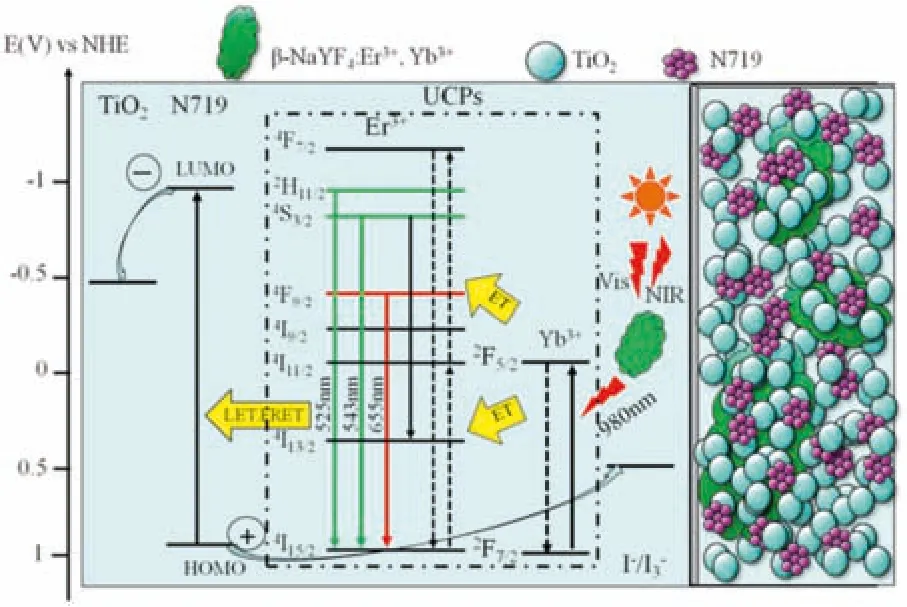
Fig.7.The energy levels of the β-NaYF4:Er3+,Yb3+UCPs,N719 dyes and TiO2,as well as the upconversion and energy-transfer processes in DSSCs.Reproduced with permission[81].Copyright 2019,John Wiley and Sons.
Recently,Ambapuram et al.proposed a novel and unique photoelectrode material with add-on layer and cosensitization treatment,i.e.,FTO/TiO2/LiYF4:Er3+/Yb3+/N719:SPSQ2 to improve the performance of DSSCs[82].The illustration of a schematic structure of this device is presented in Fig.8.The dual functions of LiYF4:Er3+/Yb3+material produced a record PCE of 10.53% along with a VOCof 0.66 V,JSCof 22.16 mA/cm2,and FF of 0.72 by coupling with a dye cosensitization treatment.The good performance of these devices could be assigned to the synergistic effect of(i)the complementary absorption profiles of two different dyes that could minimize the dye aggregation and maximizes the surface area,(ii)the presence of UCNPs that harvest the NIR light;In addition,as noted above,the scattering effect is also considered to improve the light harvesting,and(iii)SPSQ2 has good sensitizing abilities in the NIR region.
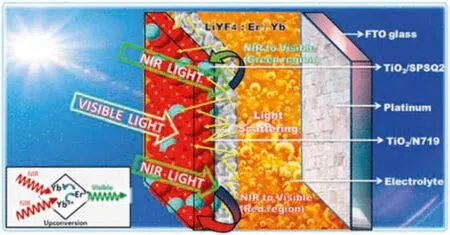
Fig.8.The illustration of a schematic structure of FTO/TiO2/LiYF4:Er3+/Yb3+/N719:SPSQ2 photoelectrode material.Reprinted with permission[82].Copyright 2020,American Chemical Society.
PSCs are thus promising next-generation solar cells with rapidly-increasing PCEs.Incorporation of UCNPs into TiO2to form UCNPs/TiO2heterostructures makes it possible not only to utilize the NIR light but also to further improve the merits of TiO2,which has been well testified for DSSCs.However,UCNPs/TiO2nanoheterojunctions have rarely been employed as electrodes of PSCs so far.In 2018,Liang et al.synthesized β-NaYF4:Yb3+,Tm3+@TiO2core-shell nanoparticles and introduced them into the TiO2mesoporous layers of PSCs for the first time[83].By optimizing several parameters,the efficiency of the PSCs could be obtained as high as 16.27%.It is about 16%higher when compared to the PCE of 13.98% of the devices without core-shell UCNPs.The improved performance of the PSCs mainly results from factors including NIR light UC and the light scattering along with the direct electron injection from the UCNPs to the CB of the TiO2.Figs.9a-e illustrate the scheme of fabrication of TiO2mesoporous films with NaYF4:Yb3+,Tm3+@TiO2core-shell UCNPs;Fig.9f presents the schematic configuration of the final PSC device.
By employing a facile one-step hydrothermal method,Zhou and co-workers synthesized Er-doped TiO2nanorod arrays which were successfully applied as electron transporting layers in PSCs[84].After Er doping,the TiO2nanorods can emit visible light while the excitation wavelength origins from the IR region,thus supplying the perovskite layer with excited energy and producing more electron and holes,leading to an increase in the electron concentration.Besides,the flat band edge of the Er-doped nanorods shifts positively,which leads to more facile electron injection from the lowest-unoccupied molecular orbital(LUMO)of the perovskite to the conduction band of TiO2by correspondingly improving the driving force,thus increasing the current density.As a result,a high PCE of 10.6%and JSCof 22.97 mA/cm2were obtained,presenting 16.5%and 20%increment in PCE and JSC,respectively,in comparison with the undoped device.The performance enhancement was attributed to the extended optical absorption induced by the UC performance,reduced electron-hole recombination and enhanced electron transfer efficiency.
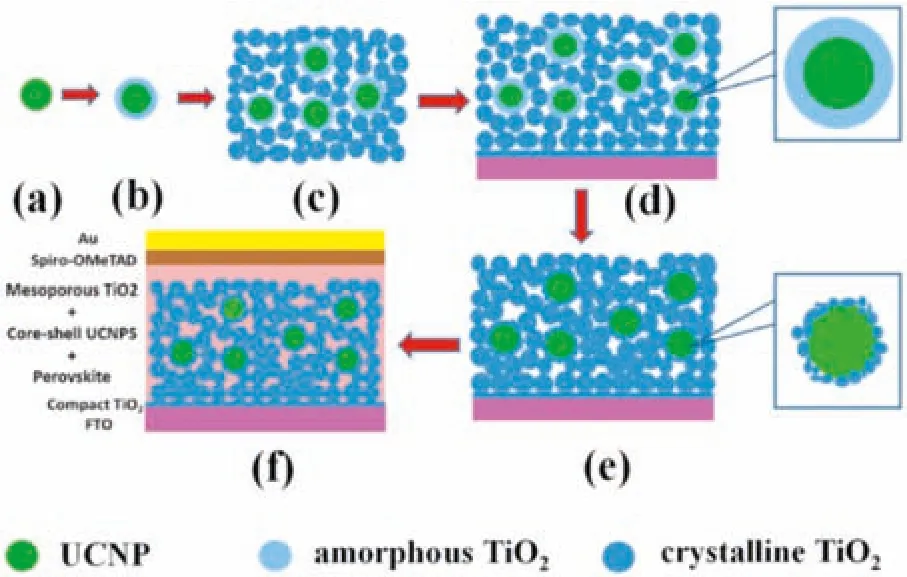
Fig.9.(a-e)Schematic illustration of the fabrication of TiO2 mesoporous film with NaYF4:Yb3+,Tm3+@TiO2 core-shell UCNPs and(f)schematic configuration of the final PSC device.Reproduced with permission[83].Copyright 2018,Elsevier.
Besides TiO2,SiO2has been utilized to form UCNPs/SiO2heterostructures and applied in PSCs.Zhang et al.reported that the introduction of hexagonal NaYF4:Yb3+,Tm3+@SiO2UC nanoprism layers into the hole-transport-layer(HTL)of free carbon-based perovskite solar cells(C-PSC)could improve its PCE(Fig.10)[85].This layer on the top of the TiO2scaffold performs multiple functions:(i)the UCNPs can convert NIR light to visible light and thus broaden the absorption range;(ii)the nanoprisms serve as light-scattering centers to increase the light-transmission distance and improve the light harvesting;(iii)the SiO2capping layer could inhibit charge recombination at the interface of perovskite/TiO2by a passivation effect.With this device,a PCE of 14.47%was obtained,coupled with a JSCof 22.02 mA/cm2,a VOCof 0.996 V,and an FF of 0.66.The PCE is 16.1% higher in comparison with that of the reference.In addition,the unencapsulated device after interface modification showed strong stability against moisture and heat.It was also demonstrated that this UC nanocrystal-based C-PSC could be applied as a photodetector which may possess high sensitivity of 980 nm NIR light and a responsivity of 0.09 mA/W2.
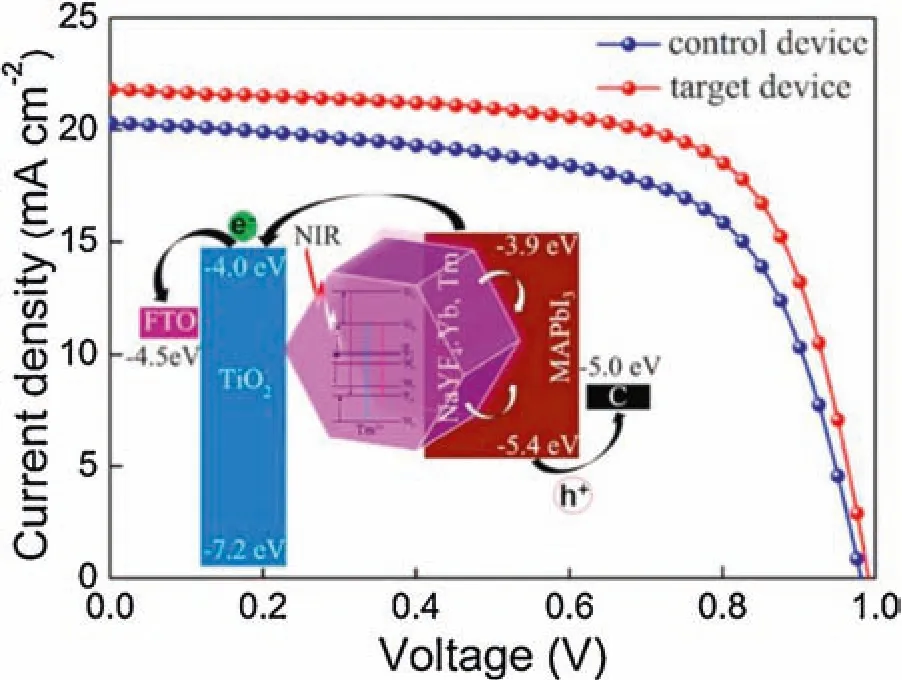
Fig.10.J-V curves of a hexagonal NaYF4:Yb3+,Tm3+@SiO2 upconversion nanoprismmodified TiO2 scaffold.Reprinted with permission[85].Copyright 2019,American Chemical Society.
Later on,Qi et al.proposed a novel bilayer electron transport scaffold of SiO2/NaYF4:Yb,Er@SiO2modified TiO2nanorods to improve the performance of hole-transport material-free(HTMfree)PSCs(Fig.11)[86].With the help of the 1D nanorod structure of the underneath TiO2scaffold,the charge recombination was suppressed.In addition,the insulating capping layer of NaYF4:Yb,Er@SiO2can further remove charge shorting pathways formed by the tangle of TiO2nanorods with the carbon back contact and thus restrain the charge recombination.Moreover,the upconverted NIR light into visible region by NaYF4:Yb,Er can improve the PSCs current density when directly used in these perovskite materials.Such PSCs showed an average PCE of 14.01%±0.53%.It was demonstrated that by using core-shell hexagonal NaYF4:Yb,Er@SiO2,up-conversion of light at 980 nm was possible but that the improvement was small.This is a new method to fabricate HTM-free PSCs.
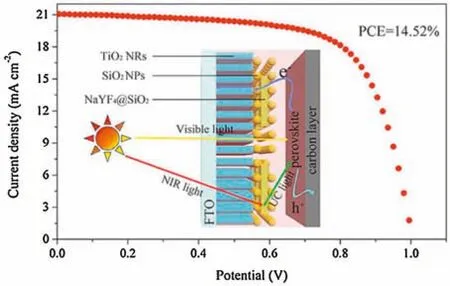
Fig.11.Schematic diagrams of the energy transfer process in PSCs and J-V curves of PSCs based on TiO2 NRs with SiO2 or SiO2/NaYF4:Yb,Er@SiO2 insulating layer measured under a 300 mW 980 nm NIR laser irradiation.Reproduced with permission[86].Copyright 2019,Elsevier.
2.2.Plasmon enhanced upconversion solar cells
A theme of the work reviewed above is that incorporation of UCNPs in PSCs is considered to be a promising way for utilizing the NIR light in the solar spectrum.However,its realization is not simple because of the vulnerability of perovskite materials under humid environments.To further improve the UCL of the UCNPs,the involvement of metal nanostructures with strong SPR has been suggested and evaluated as effective method for that purpose.
By applying the dry transfer technique,Park et al.inserted NaYF4:Yb3+,Er3+UCNPs onto any position within a PSC structure without damaging the perovskite film[77].The photoluminescence(PL)of the UCNPs on ETL/perovskite/FTO was measured by using an exciting laser of 980 nm irradiated on the top side for the bare UCNPs.The relative schematic illustration is shown in Fig.12a.The Au film-deposited UCNPs exhibiting the plasmon enhanced up-converted light are plotted in Fig.12b.When Au nanoparticles were deposited,the UCL was enhanced by 6.5 times as compared with that of the bare UCNPs.In addition,the maximum PCE of 15.56% was achieved when the UCNPs of the PSCs were located between the HTL and Au top electrode,showing an improvement of 8.4% in comparison with the cell without the UCNPs.Such an enhancement was ascribed to both the NIR light harvesting and the SPR phenomenon in the Au nanoparticles deposited on UCNPs.

Fig.12.(a)Schematic illustrations of the PL measurement of UCNPs on ETL/perovskite/FTO.(b)Au film-deposited UCNPs exhibiting plasmon enhanced up-converted light from the UCNPs.Reproduced with permission[77].Copyright 2019,the Royal Society of Chemistry.
The SPR phenomenon of Au nanoparticles was also utilized by Bi et al.to increase the photovoltaic efficiency of PSCs coupled with IR-783 dye-enhanced NaYF4:Yb3+,Er3+@NaYF4:Yb3+,Nd3+UCNPs[87].The IR-783 dye molecules were employed as antenna to absorb NIR photon energy which was then transferred to Yb3+.Furthermore,the efficient absorption cross section of dyes could be increased by the coupling of SPR leading to the enhanced luminescent quantum yield of the UCNPs by utilization of the IR light.As a consequence,the UCL intensity was significantly enhanced by 120-fold,while the luminescent quantum yield was increased from 0.2%to 1.2%under a 980 nm light irradiation.It was the first time that dye and metal-enhanced UCNPs were used for the improvement of the performance of PSCs.The photovoltaic efficiency was improved from 19.4%to 20.5%under simulated AM 1.5 G sun irradiation(100 mW/cm2)with the composite UCNPs fabricated on the SnO2layer of the PSCs.Up to the published date,this is record high photovoltaic efficiency for PSCs on the basis of various UC devices.Fig.13 shows the structure of PSCs and scattering and reflecting mechanism diagram as well as the cross-sectional view of the PSC device.
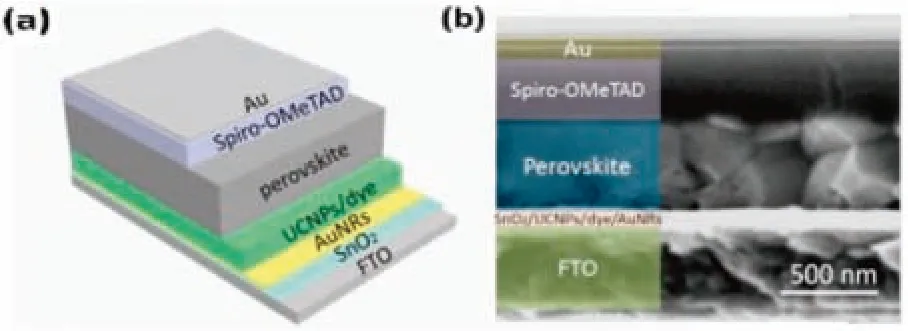
Fig.13.(a)Structure of PSCs and scattering and reflecting mechanism diagram.(b)Cross-sectional view of the PSC device.Reprinted with permission[87].Copyright 2020,American Chemical Society.
UC of sub-band-gap photons is considered as a promising strategy to increase the photovoltaic efficiency of silicon-based solar cells with the potential to break the Shockley-Queisser limit.The trivalent erbium ions causing UC from 1500 nm to 980 nm were found very suitable for this purpose;however,the small absorption cross section limited their large-scale practical applications.Christiansen et al.employed tailored Au nanoparticles in erbium-containing TiO2thin films(Fig.14),largely enhancing the UC efficiency[88].The parameter optimization was used to design the nanostructures and electron beam lithography was used in their synthesis process.The samples showed remarkable electric-field improvements inside the upcoverting films under 1500 nm laser excitation for both s-and p-polarizations with a broad range of excitation intensities and incidence angles,which is qualitatively consistent with a theoretical model.An unheard-of UC improvement of 913±51 was detected at 1.7 W/cm2.A semi-empirical expression was derived for the photonically improved UC efficiency,which is applicable for all excitation intensities.The model further considers experimental measurements for the concentration of the mean EM energy density in the upconverting film,which is a key factor in estimating the adaptability of photonic improved upconverters for applications in solar cells.
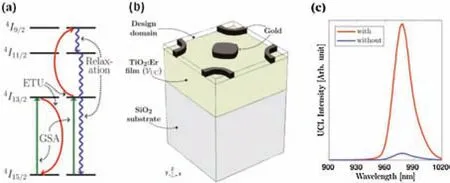
Fig.14.(a)The excitation process showing two erbium ions.(b)The model setup.(c)The upconversion-luminescence exemplifying by two spectra with the measured UCL with(red)and without(blue)the Au nanoparticles deposited on the film surface.Reproduced with permission[88].Copyright 2020,Elsevier.
Balling et al.reviewed ongoing activities designed to enhance the spectral-conversion processes by means of suitably designed plasmonic nanoparticles[89].These nanoparticles,which acted as light-concentrating elements,were applied for enhancing the non-linear UC.Theoretically,the finite-element modelling of the plasmonic near fields were employed to optimize the nanoparticles,along with the topological analysis for the particle geometries.Experimentally,the electron beam lithography was used to synthesize the nanostructures on the thin films containing the foremost TiO2fabricated by radio-frequency magnetron sputtering,Er3+-doped transparent materials,and the chemically synthesized NaYF4nanoparticles layers.Various optical methods such as the time-resolved luminescence spectroscopy were used for the measurement of the properties of the upconverters.The computed near-field improvements could be verified by a nearfield-enhanced ablation technique with tunable ultrashort laser pulses.A typical example is shown in Fig.15,which introduces the procedure for achieving the 3D marking experimentally.
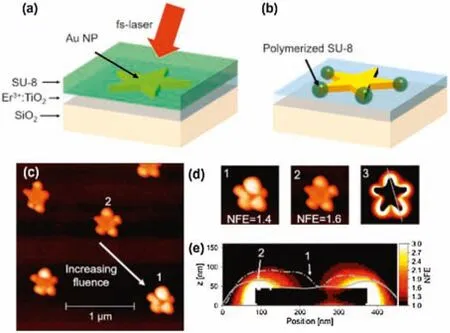
Fig.15.Procedure for 3D marking of the optical near fields by multiphoton polymerization.(a)A plasmonic gold nanostar on top of a Er3+:TiO2 film is covered by a layer of SU-8(approximately 1μm thick).(b)The polymer is developed,leaving only the polymerized SU-8 behind.(c)AFM image of nanostars subjected to the near-field-marking procedure,showing SU-8 at the tips where significant NFE occurs.(d)Close up of the two nanostars labeled 1 and 2 together with the corresponding values of NFE.(e)Comparison between simulated near-field distribution with contours.Reproduced with permission[89].Copyright 2018,Elsevier.
Zhao et al.synthesized the UC composite nanofibers consisting of double-shell CeO2:Yb,Er@SiO2@Ag by using electrospinning and subsequent processing[90].These nanofibers showed a high UCL property because of the SPR effect of the Ag nanoparticles and the coating of amorphous SiO2,which acted as an assistant layer in DSSCs and enhanced the PCE to 8.17%,corresponding to an enhancement of 22.86%.The J-V curve was gained by using a 980 nm laser source.Moreover,the absorption of the incident photon-to-current conversion efficiency(IPCE)curve in 900-1000 nm NIR light confirmed that the introduction of the UC nanomaterials could widen the spectral response range,thus improving the use of the sunlight and increasing the photovoltaic efficiency of the DSSC devices.
To improve the one-Sun photoelectronic performance,Chen et al.reported a composite module of GaAs solar cells by harvesting the long-wavelength photons below the bandgap with plasmonically enhanced spectral UC[91]as shown in Fig.16.Microscale and ultrathin GaAs solar cells were released from the growth wafer and etched with a bottom contact layer and then printed on a polymeric waveguide comprising the NaYF4:Er3+,Yb3+upconversion nanocrystals(UCNC),which were coated on a plasmonic reflector containing a hole-post hybrid silver nanostructure.The PCE of GaAs microcells on a UCNC-doped plasmonic substrate was increased by~11.8%(relative)and~6.4%(relative),respectively,in comparison with those on a plain silver reflector with UCNC and on a nanostructured silver reflector without UCNC.This was attributed to the impact of local electric-field amplification to improve the absorption of the UCNC and to the broadened upconverted emission through the coupling into radiative modes,as well as to the waveguided photon concentration.
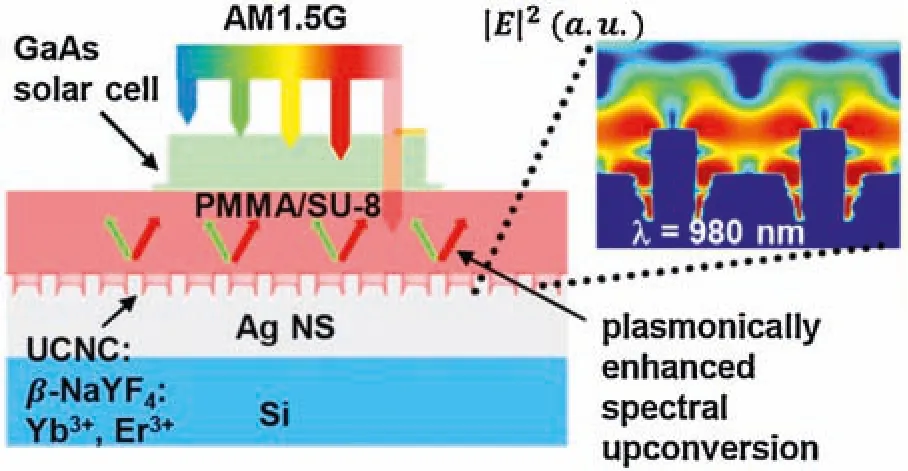
Fig.16.A schematic diagram of the composite module of GaAs solar cells.Reprinted with permission[91].Copyright 2018,American Chemical Society.
2.3.Co-doped upconversion solar cells
In 2018,Kumar et al.synthesized Er3+and Yb3+co-doped ZnO UCNP based phosphors by employing the solution-combustion method[92].Strong UC emissions of these UCPs were presented at wide spectral regions,such as,red,green and blue wavelengths,with the excitation of a 980 nm diode laser source.In order to explore the effect of ZnO:Er3+-Yb3+UC nanoparticles on the performance of DSSCs,the UCNPs were incorporated into the scattering layers of TiO2films in the form of a composite photoanode(Fig.17).The results showed an increase of the PCE of the DSSCs from 8.34% to 8.72% after using the ZnO:Er3+-Yb3+UCNPs.This improvement in the PCE can be ascribed to the increase of the JSCof 18.66 mA/cm2.Such an enhancement in the JSCis mainly due to the extended light-harvesting region from infrared into the visible light,while the PCE was 8.34% for the reference DSSC(without UC layer),with the corresponding JSCof 17.89 mA/cm2.
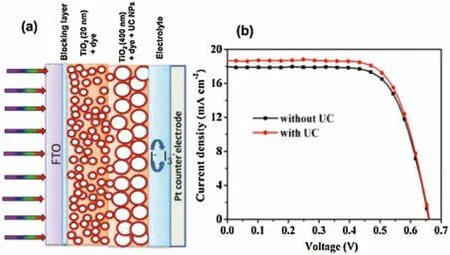
Fig.17.(a)Schematic diagram of UC based DSSC and(b)photovoltaic performance curve of DSSCs with and without UC.Reproduced with permission[92].Copyright 2018,Elsevier.
Markoseetal.reported the synthesis of three Yb3+/Er3+co-doped UCPs(YF3,YOF and Y2O3)by using a co-precipitation method and explored their application in amorphous silicon thin film solar cells[93].Their UCL showed strong emission at 540 nm and 660 nm under excitation at 980 nm(Fig.18).When the UCPs were incorporated at the rear side,the solar cell exhibited remarkable improvement in short-circuit current.As a result,an enhancement of7.5%in JSCforthea-Si:H solarcellwithYF3:Yb3+/Er3+wasachieved on AM 1.5 G together with NIR illumination.
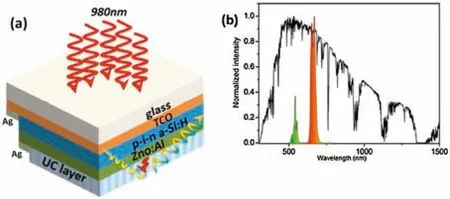
Fig.18.(a)Diagram of the scheme used,where the UC phosphor is coupled at the rear of the solar cell.(b)The overlap between the normalized emission bands of the YF3-Yb3+/Er3+UC phosphor with the AM1.5 G standard spectrum.Reproduced with permission[93].Copyright 2018,Elsevier.
IR to NIR UC is an effective approach to promote solar light utilization by decreasing the spectral mismatch between the c-Si solar cells and the solar spectrum.Er3+4I11/2→4I15/2transition,mainly occurring at~1000 nm,is mostly used to realize this process by Er3+singly doped phosphors.However,the efficiency of this transition is limited owing to the multiphonon relaxation and radiative decay to the4I13/2state.In the work of Wu et al.[94],Yb3+ions were incorporated in Y2O3:Er3+,and thus the NIR UC emission intensity was improved by 1.5 times owing to the high efficiency of both the Yb3+emission and energy transfer from Er3+to Yb3+(Fig.19).They also studied the effect of the dopant concentrations on the UC dynamics-the optimal concentration by using IR excitation was found to be 5% Er3+and 1% Yb3+.It indicates that incorporating Yb3+ions into Er3+singly doped phosphors may make remarkable improvement in the IR to NIR UC performance.
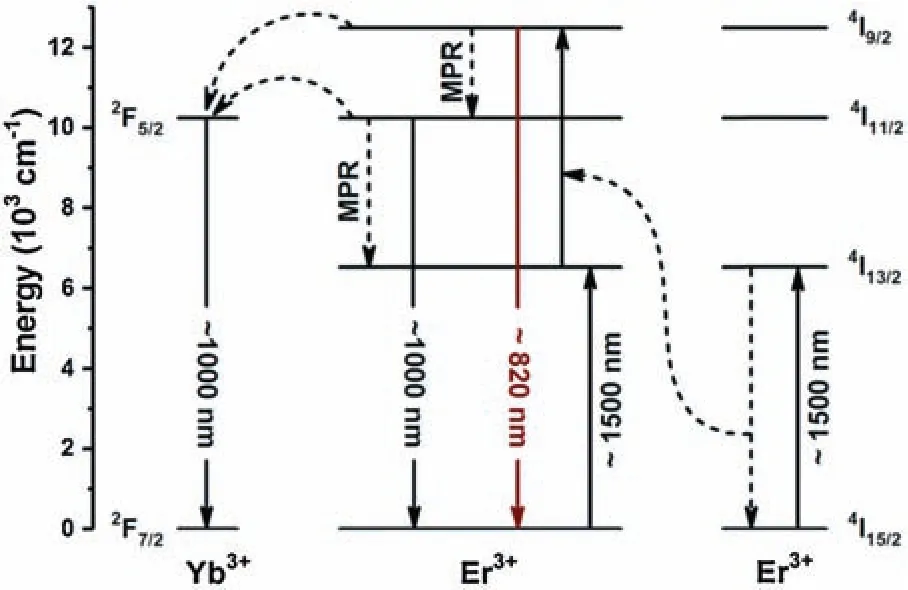
Fig.19.Simplified energy level diagram of Er3+and Yb3+with the NIR UCL and the proposed ET processes.Reproduced with permission[94].Copyright 2020,the Royal Society of Chemistry.
In 2018,Li et al.[95]first added NaYbF4:Ho3+UCNPs into ZrO2to form a novel upconverting scaffold layer for a mesoporous structure of FTO/compact TiO2(cp-TiO2)/mp-TiO2/mp-ZrO2/FA0.4MA0.6PbI3/CE.A device structure was fabricated as that presented in Fig.20.ZrO2has a higher energy level and larger band gap in the conduction band,which is even higher than the perovskite conduction band.Besides,ZrO2can prevent the contact of the carbon counter electrode(CE)and TiO2,which is favorable for improving the photovoltage.As compared with the NaYF4:Yb3+/Er3+,NaYbF4:Ho3+UCNP has the higher UCL.The merged NaYbF4:Ho3+and ZrO2would widen the absorption range of the PSC and lead to a higher PCE.A 14.32%PCE was achieved,which is an increase of 28.8% in comparison with conventional ZrO2nanoparticle-based PSCs(11.12%).
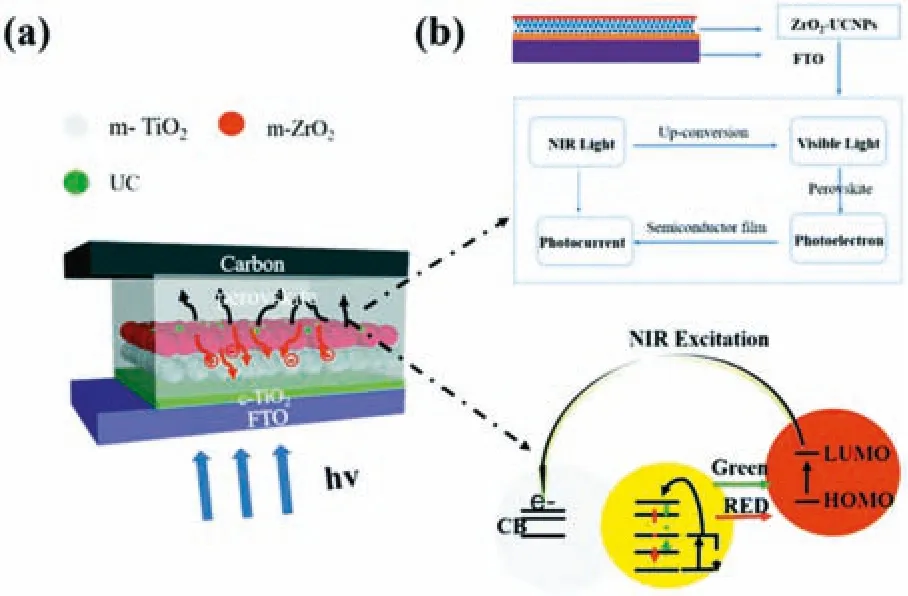
Fig.20.(a)Schematic view of the device and the charge carrier transportation process in the mp-TiO2/mp-ZrO2:UCNP/perovskite/C architecture.(b)Mechanism of NIR sunlight harvesting in ZrO2:UCNP PSCs.Reproduced with permission[95].Copyright 2018,the Royal Society of Chemistry.
In 2019,Guo et al.[71]reported the synthesis of core-shell β-NaYF4:Yb3+/Er3+/Sc3+@NaYF4nanoparticles for which the codoped Sc3+ion is beneficial to improve the UCL intensity.With the optimal concentration of β-NaYF4:20%Yb3+/2%Er3+/8%Sc3+,improvements of 10 and 16 times for the total UC intensities were achieved for green and red emissions,respectively,compared with the sample without Sc3+doping.Then,a scaffold layer about 150-200 nm with various UCNPs/TiO2weight ratios was elaborately prepared by using a spin coating mixed paste at 2000 rpm for 30 s followed by anneal at 500°C for 30 min.This resulted in an enhanced PCE of 20.19% for the PSC,compared to 17.44% for the device on the basis of the clear TiO2mesoporous layer.This work provides a feasible pathway to afford the minimization of nonabsorption loss for solar photons along with improved energy alignment of PSCs.
In order to explore the effect of upconverting nanophosphors on the photovoltaic performance of DSSCs,Dutta etal.introducedY2O3:Ho3+/Yb3+UC nanophosphors into a TiO2film to form a hybrid film[96].DSSCswithoutU C nanophosphors showedaVOCof0.68 V,JSCof 16.75 mA/cm2,and FF of 51.29%and PCE of 5.84%,while the DSSCs hybrid film exhibited VOC=0.71 V,JSC=21.9 mA/cm2,FF=48.84%,and PCE=7.59%.DSSCs with the UC nanophosphors thus showed a~30%improvement in PCE.This significant improvement in the PCE was ascribed to not only an efficient energy transfer from the Yb3+to the Ho3+ions after UC emission from NIR to visible,but also the enhanced light scattering.
At present,highly doped levels of lanthanide ions induce NIR UC quenching that significantly limits their practical applications.Sun et al.prepared Tm3+/Yb3+co-doped Na0.5Bi2.5Nb2O9(NBN)materials in a layered structure,which exhibited a single-band NIR to NIR UC emission(980 nm excitation,808 nm emission)without obvious concentration quenching even at 90 mol%content of Yb3+(Fig.21)[97].It also showed good thermal stability.
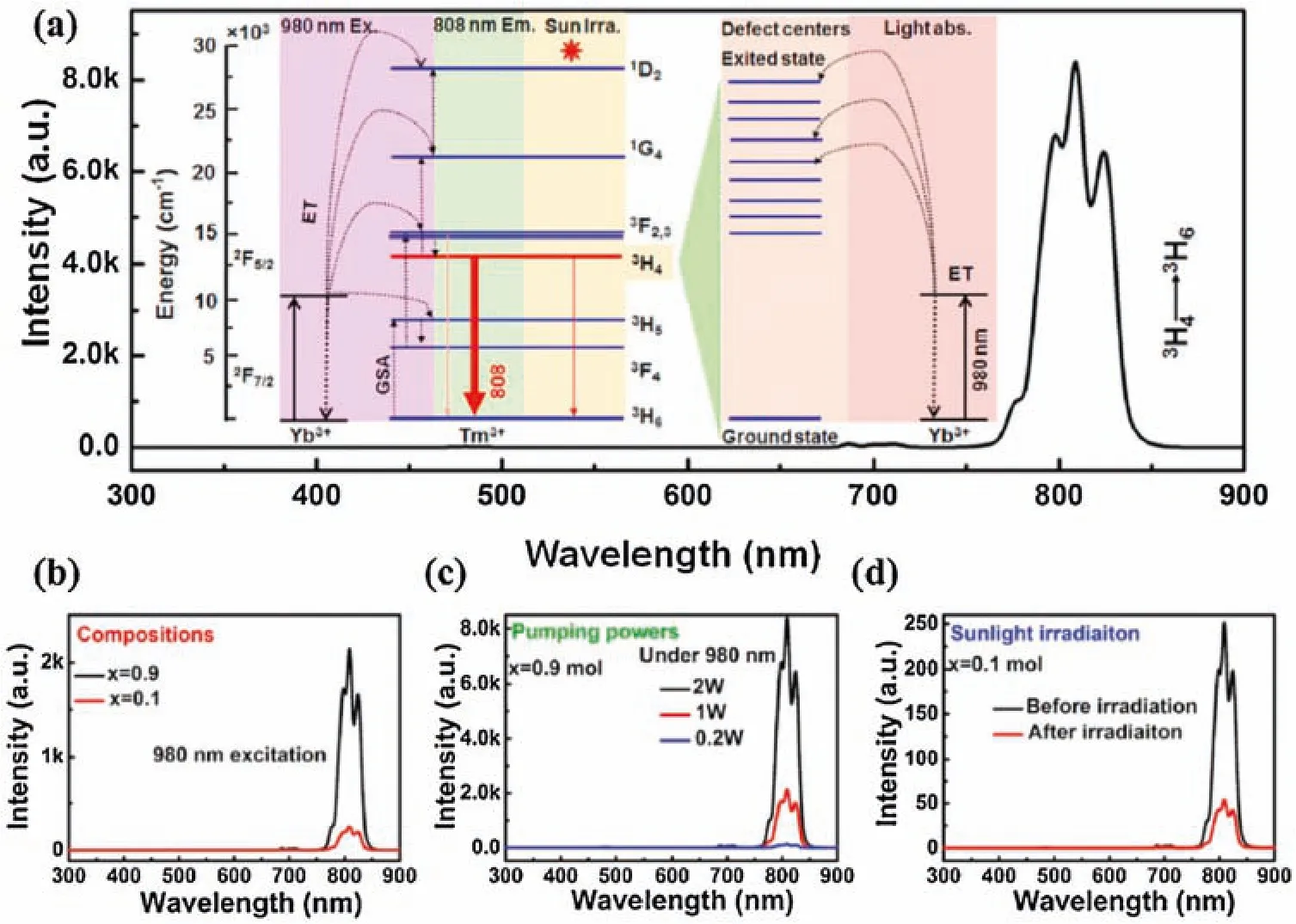
Fig.21.(a)Room temperature NIR emission spectra of the NBTN:0.9 Yb3+sample under 980 nm excitation(2 W),the inset is the energy transfer level for Tm3+and Yb3+ions.(b)NIR emission spectra of the NBTN:xYb3+(x=0.1 and 0.9 mol)samples under 980 nm excitation(1 W).(c)NIR emission spectra of NBTN:0.9 Yb3+with different pumping powers(0.2 W,1 W and 2 W).(d)NIR emission spectra of the NBTN:0.1 Yb3+sample under 980 nm excitation(1 W)before and after irradiation under sunlight.Reproduced with permission[97].Copyright 2019,Elsevier.
2.4.Upconverting-downconverting assisted solar cells
In 2018,Chen et al.constructed upconversion-core/downconversion-shell-structured nanoparticles to implement simultaneously NIR UC and UV downconversion[98].They applied NaYF4:20%Yb,2%Er@NaYF4:7%Eu core/shell nanoparticles to TiO2photoanodes to fabricate NIR/UV-enabled DSSC devices(Fig.22),resulting in a high efficiency of 7.66%under AM 1.0 G.The designed nanopaticles increased PCE by about 14% including a 4.82% UC function,a 7.58% downconversion contribution and a 1.55%scattering effect.
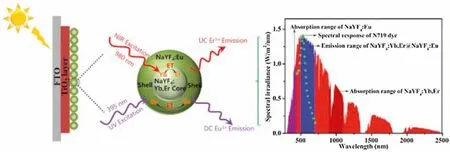
Fig.22.NIR and UV sunlight harvesting and then spectral conversion into visible range to activate N719 dye for the enhancement of a DSSC device.Reproduced with permission[98].Copyright 2018,Elsevier.
Chen et al.also proposed a strategy by inserting an inert layer into spatially separate active DC and UC layers at a precisely defined thickness[99].The construction of such sandwich nanostructured compounds NaYF4:20%Yb3+:2%Er3+@NaLuF4@-NaYF4:15%Eu3+was shown to eliminate the detrimental cross relaxation quenching,and to implement an optimal synergistic effect of the UC/DC system and further extend simultaneous absorptions of NIR and UV to a large extent for the DSSC devices(Fig.23).By incorporating such construction into the TiO2photoanode of DSSCs,the PCE was enhanced by 16.94%.An increased PCE of 7.87%was obtained.The work by Chen et al.[99]thus provides a promising approach to integrate various photon processes in one single unit and to broaden the spectral response.

Fig.23.Schematic illustration of energy-transfer processes of Yb3+→Er3+and Eu3+in the sandwiched architecture upon 980 nm/395 nm excitation.NIR and UV sunlight harvesting and then spectral conversion into visible range to activate N719 dye for the enhancement of a DSSC device.Reproduced with permission[99].Copyright 2019,Elsevier.
Li and coworkers prepared efficient plasmon-enhanced composite layers of NaYF4:Yb3+,Er3+/NaYF4:Yb3+,Tm3+/Ag which were deposited on the backlight side of the PSC device(Fig.24)[100].This increased the PCE of the UCL functionalized PSC from 16.1%to 19.2%.Subsequently the PCE could be further increased to 19.5%by applying an UV to visible down-conversion layer of Eu(TTA)2(Phen)MAA at the incident light side of the PSCs.
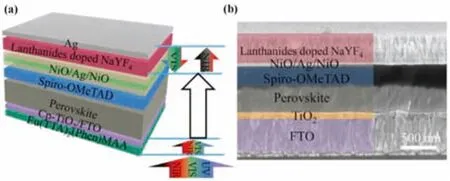
Fig.24.Structure and characterization of PSCs.(a)Schematic configuration of a complete PSCs.(b)Cross-sectional SEM image of the complete device.Reproduced with permission[100].Copyright 2018,Elsevier.
2.5.Other technologies
Upconversion nanoparticle hybrid solar cells:Sebag et al.presented a macroscopic as well as microscopic feature of capturing the upconversion-induced NIR light in solution-processed hybrid PSCs[101].They prepared a uniform and highly crystalline KY7F22 UCNPs by co-doping 20 mol% Yb3+and 5 mol%Er3+,showing an average diameter of 183 nm.The UCNPs were introduced into the different interfaces of a functional solar cell containing a mixed-cation lead mixed-halide perovskite FA0.83Cs0.17Pb(I0.6Br0.4)3(FA=formamidinium[HC(NH2)2]).When applying an optimal UCNP solution concentration,the PCE of these UCNPs was improved by about 6.1%and 6.5%in the front-and rearside NP insertion configuration,respectively,in comparison with the control device.To give a quantitative description of the UC contribution,by employing the LBIC/fluorescence mapping technique,microscopic solar cell characterizations were performed on devices using only half of the perovskite/HTL interface(Fig.25)purposely covered with manufactured UCNPs.These mapping experiments gave particular microscopic and spectroscopic evidences making them possible to correlate the electrical and optical contribution of the UCNPs in combination with the solar cell morphology.
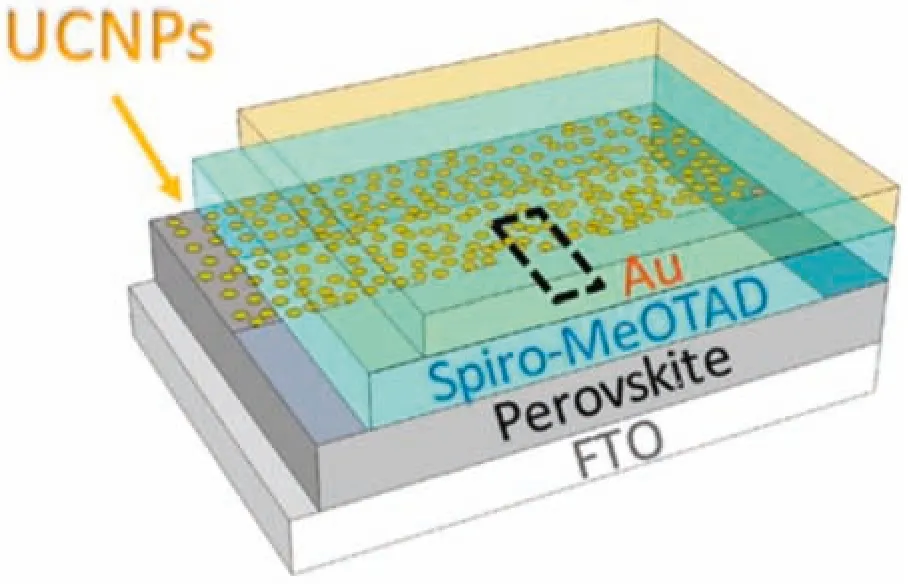
Fig.25.Schematic(not to scale)of the UCNP-incorporated PSC structure.Reprinted with permission[101].Copyright 2018,American Chemical Society.
Upconversion layered solar cells:Wang et al.designed ultrathin Si solar cells patterned with resonant α-NaEr0.2Y0.8F4UC nanosphere(NS)arrays on the surface as an antireflection(AR)layer and UC layer[102],which significantly increases the optical path as well as the absorption from leaking into the absorber layer by the resonant modes in the NSs.The effect of different NS diameters and ratios on the average optical performance of such solar cells was calculated.The average optical absorption of the solar cells was enhanced by 8.5%relative to planar ones with the same thickness of silicon.The improvement is attributed to both the reduction of optical reflection and the enhancement of optical absorption by the spherical nanostructures.
Upconversion nanoparticles in hole-transport layers:By using the thermal decomposition method,Deng et al.synthesized Li(Gd,Y)F4:Yb,Er UC nanophosphors with tetragonal bipyramidal morphologies[103].The octahedral UCNCs were then blended into the HTL based of Spiro-OMeTAD in the PSCs(Fig.26).When UCNCs was added at an optimal weight ratio,the PCE could reach 18.34%under the AM 1.5 G illumination,with an improvement of over 25% in comparison with the PSCs on the basis of conventional HTL(14.69%).The introduction of UCNCs in HTL not only increases the mobility and transfer/collection capability of the charge carrier,but also enhances the light harvesting from 400 nm to 800 nm.Furthermore,the embedded UCNCs up-converted the NIR light to expand the absorption for the PSCs.The work by Deng et al.[103]thus provides a way to incorporate NIR upconverting nanocrystals into PSCs for high performance.
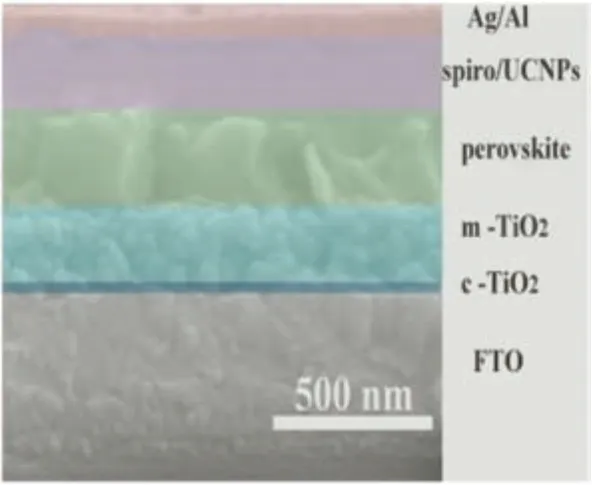
Fig.26.Cross-section SEM image of a UC-PSCs.Reproduced with permission[103].Copyright 2019,Elsevier.
Microlens assisted upconversion solar cells:Polymer-based microlens arrays(MLAs)can be used to spatially regulate the excitation light.The light concentration induced by the MLA can result in a remarkable UCL improvement due to the non-linear nature of the UC behavior.Recently,Liu et al.proposed to use MLAs as light concentrators to irradiate the UCNPs and explored the influence of the spatial light regulation on the resulting UCL[104].Their studies revealed that the multicolored UCL from two prepared core/shell UCNPs could be improved by over 10 times under excitation light of either 980 or 808 nm,with a polymeric MLA simply put onto the top of these samples.In order to explore the impact of the introduction of MLA on UCNP-enhanced DSSCs,they further prepared four DSSCs,including a reference cell without UCNPs,a UCNP-incorporated cell,an MLA-incorporated cell and a cell incorporated using both UCNPs and MLA.Fig.27a presents the layout of the device,and the J-V curves of the four DSSCs devices under AM 1.5 G light irradiation are depicted in Fig.27b.It was found that the reference DSSC achieved a VOCof 0.698 V,a JSCof 13.20 mA/cm2,and an FF of 0.58,corresponding to a PCE of 5.36%.By adding the UCNPs onto the photoanode,a PCE of 5.53% was obtained for the UCNP-incorporated DSSC,showing a 3.17%efficiency improvement in comparison to the reference cell.With the addition of a piece of MLA onto the photoanode,the PCE of the MLA-incorporated DSSC could be further improved to 5.75%.By incorporating the UCNPs and MLA in the device,the resulting DSSC realized a best PCE of 5.87%.These results clearly indicated that their proposed MLA method could have immediate ramifications to improve the photovoltaic performance of the DSSC devices.
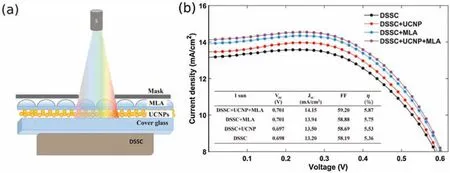
Fig.27.(a)Schematic illustration of the configuration of UCNP-and/or MLA-enhanced DSSC.S-source(b)The J-V characteristics of DSSC,DSSC+UCNP,DSSC+MLA and DSSC+UCNP+MLA under AM1.5 G light irradiation(0.1 W/cm2).Reproduced with permission[104].Copyright 2019,the Royal Society of Chemistry.
Triplet-triplet annihilation upconversion solar cells:Photon UC viatriplet-triplet annihilation(TTA-UC)is consideredas an effective pathwayto increase themaximumtheoretical solar cell efficiencies.The TTA mechanism is triggered by singlet absorption of the sensitizer followed byan intersystemcrossing fromthe singletstate to the triplet state,and then the triplet energy transfers from the sensitizer to the emitter.Two emitter triplets then collide to generate a high energy excited singlet state of the emitter,which then in turnundergoes a delayed upconverted fluorescence.Thereis obviously a great number of combinations of sensitizers and emitters that can be synthesized and tested for efficiency and wavelength coverage.Although it can be expected that this long chain of events is associated with a low cross section,it has been shown that TTA based UC can give a quantum yield as high as 40%,even at very low excitation intensities as 1-10 mW/cm2,which is considerably lower than the standard sun value of 100 mW/cm2.Thus the TTA process is indeed a strong competitor to sequential absorption,taking place in,e.g.,lanthanide ions.However,the transmission window between sensitizer and acceptor molecule absorption is a non-negligible factor that limits the integrated performance of TTA-UC solar cells.As an example of a recent effort to use TTA to improve solar cell performance we can mention the work by Zhou et al.[105]who found that the introduction of a singletsensitizer(SS)intoaself-assembledtrilayercouldeffectively harness the previously transmitted light(Fig.28).They achieved a record photocurrent density of 0.315 mA/cm2with the TTA-UC device,which was attributed to directional singlet energy transfer from singlet sensitizer to triplet sensitizer(S)and triplet energy transfer from S to acceptor,as well as the following TTA,excited-state electron injection into TiO2,and regeneration by a redox mediator in solution.
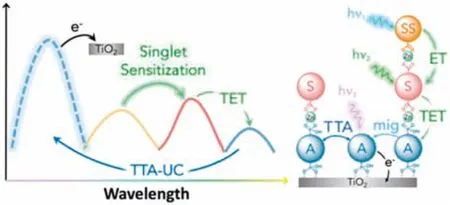
Fig.28.Schematic representation of self-assembled trilayer(TiO2-A-Zn-S-Zn-SS)and the corresponding excited energy transfer and electron transfer process(SS=singlet sensitizer;S=triplet sensitizer;A=acceptor;ET=singlet energy transfer;TET=triplet energy transfer;mig=triplet exciton migration;TTA=triplet-triplet annihilation;UC=upconversion).Reprinted with permission[105].Copyright 2019,American Chemical Society.
3.Discussion
The present work was motivated by the steep increase in the number of research works concerning upconversion(UC)assisted solar cells that we have witnessed during the last few years.The progress represents the consideration of a number of advanced processes,effects and materials.Perhaps the most cherished research in this area has concerned the incorporation of upconverting nanophosphors directly into the photoanodes of the solar cells.Here a significant increase in the JSC,VOCand PCE could be established.Another popular approach is to construct intricate configurations where plasmonic metal nanoparticles coexist with the UCNP particles.As the UC is non-linear the field enhancement by plasmon generation has a direct and strong bearing on the conversion efficiency of the solar cells.For the same reason(non-linearity)also focusing of the IR light by microlenses or holographic techniques can have a pronounced effect,as reviewed here.In several of these applications further enhanced UC actions have been triggered by broad band and effective harvesting by organic IR antennas,with subsequent mediation by an intermediate nanoshell of the energy into the upconverting core.Codoping,nanohybrid and layer-by-layer technology involving upconverting particles as well as the use of UCNPs in holetransport and electrolyte layers have been tested in many recent works.Solar cells with coexisting upconverting and downconverting nanoparticles have been designed in order to harvest energy also from the unutilized UV part of the solar spectrum.We have also reviewed work with TTA-UC solar cells,with different merits and limitations than UC based on sequential absorption.The two approaches are thus complementary in many respects and will certainly both be significantly researched in the near future.
It is safe to say that theory still lags experiment in the upconversion area,in particular concerning lanthanide crystal sequential upconversion.This can be traced to the complication of heavy element in many open shell systems,where both strong relativistic and strong correlation effects play a role,making it a challenging task to well simulate the electronic structure.Thus to describe photon upconversion of materials which contain d-block and f-block elements with predictive power,one requires a methodology which is highly accurate,generally applicable,and efficient at the same time.Such a methodology is available today for heavy element atoms and dimers,but not really for larger molecules or clusters containing heavy elements.This is particularly true for lanthanides,and lanthanide complexes.These systems are extremely challenging for computational approaches for the following reasons:1)an accurate description of the electronic states of such systems requires a balanced description of both electron correlation and relativistic effects,2)many electrons per atom have to be correlated,and 3)a large number of valence electrons are unpaired,often in multiple open shells.In the lanthanide series,the 4f shells are partially filled which yields a large number of possible states due to the high degeneracy of the f shells.An additional complication is the fact that the open f shell is often accompanied by open 5d,6s and 6p.As an example,the Gadolinium dimer contains 18 unpaired electrons.A rigorous approach for electronic structure calculations of lanthanide complexes therefore comprises correlated methods based on the four-component Dirac-Coulomb Hamiltonian,where spin-orbit coupling is treated variationally from the start and not introduced a posteriori at a late stage of the calculation.The price to pay for a variational treatment of spin-orbit coupling is the loss of spin symmetry because the spin-and spatial degrees of freedom are then coupled.Apart from electronic structure theory,phenomenological models also play a role.For instance,the modelling of the Förster-and Dexter-type energy transfer processes are involved in dye sensitized core-shell upconverison with multistep energy transfer pathways.
Apart from theory there are a number of technological pathways to move ahead for improving upconversion technology for solar cells--this concerns materials,processes and technological implementations.A promising way ahead is simply to combine technologies that already exist,for instance with dye sensitized upconversion which now has diversified to a research field on its own and where the insufficient light harvesting problem of rareearth doped nanoparticles is greatly alleviated by using organic dye harvesting elements[70].Here we can envisage that a combination of the favorable properties of organic dyes and inorganic UCNPs in the form of new organic-inorganic hybrids can produce orders of magnitude higher brightness,with diversified and flexible excitation wavelengths.This field is wide open for optimization.
A way forward is also to explore special core-shell-structured UCNPs that are able to harvest light energy in multiple NIR regions[65],and subsequently convert the absorbed energy into visible light where the DSSCs strongly absorb.Such NIR-insensitive DSSCs show compelling photocurrent increases through binary or multiple upconversion under NIR light illumination at more than one wavelength.As for other constructions it is important to separate pure scattering(which though can be useful in certain contexts)with that of real upconversion.
Another promising combination path is to employ cascading processes,for instance by combining plasmonic and microlens upcorverision,which can generate extreme enhancement of intensity hotspots[106].This can be a way to conquer the relatively high pumping threshold of UCNPs.Such a novel cascade optical field modulation strategy was explored,in which the super lensing effect of dielectric microlens arrays and the plasmonic effect of gold nanorods were cascaded,and where one could show an efficiency enhancement more than four orders of magnitude under weak light irradiation.The application to photodetectors of this technology showed impressing numbers,and it is credible that a concomitant implementation in solar cells could as well[106].
Yet another path forward combining elements of absorption,energy transfer and emission concerns organic-inorganic hybrid TTA systems for NIR to visible upconversion.These use a NIR dye as molecular sensitizer and lanthanide-doped nanoparticles as an energy migration platform to triplet excite an organic chromophore which is followed by triplet-triplet annihilation of the chromophores.That leads to synergistic effects that enhance the intersystem crossing rate and the energy migration from lanthanide ions in the nanoparticles leading to a 20-fold increase in the upconversion intensity compared to the pure organic TTA system.This concept in which hybrid organic-inorganic NP systems enhance the performance of organic TTA systems provides ample opportunities for further optimization for the conventional triplet-triplet annihilator systems.
These are just a few of many examples of possible strategies to move ahead in upconversion solar cell technology.The path forward is wide open,with respect to the fundamental understanding and utilization of basic processes,as well as testing new materials and solar cell constructions.We can confirm the end statement of the previous review[59],that the field is wide open for further research,with potentially great impact on solar cell technology and exciting results for the energy sector and the public.
Declaration of competing interest
The authors report no declarations of interest.
Acknowledgements
HansÅgren acknowledges Drs.Guanying Chen,Haichun Liu and Paras Prasad,for many inspiring discussions through the years on upconversion technology.This work was supported by the National Natural Science Foundation of China(No.21975064),Program of Henan Center for Outstanding Overseas Scientists(No.GZS2020011),Henan University’s First-class Discipline Science and Technology Research Project(Nos.2018YLTD07,2018YLZDYJ11,2019YLZDYJ09),and the Excellent Foreign Experts Project of Henan University.
杂志排行
Chinese Chemical Letters的其它文章
- Aryl groups,supplement of amino protecting group chemistry!
- Quinuclidine and its derivatives as hydrogen-atom-transfer catalysts in photoinduced reactions
- Nanomaterials toward the treatment of Alzheimer’s disease:Recent advances and future trends
- Recent advances in bismuth vanadate-based photocatalysts for photoelectrochemical water splitting
- Optical recording of brain functions based on voltage-sensitive dyes
- Enhancing the immune response and tumor suppression effect of antitumor vaccines adjuvanted with non-nucleotide small molecule STING agonist
